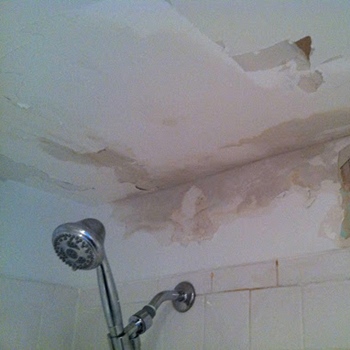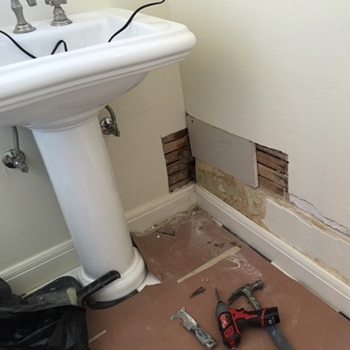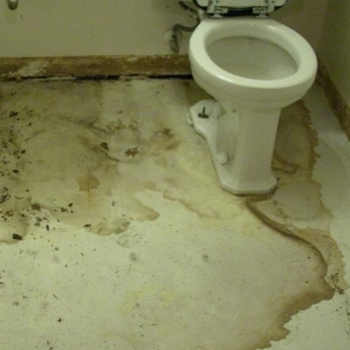One of the worst enemies of your bathroom is water damage. Even though bathrooms are one of the most humid rooms in a standard home, they are not completely impervious to water damage. If something goes wrong due to leakage or the tooth of time, the excess water will find a way and potentially cause a lot of damage. However, modern technology and years of experience taught us to prevent such situations.
In the following couple of sections, we will talk about the water damage in bathrooms – how it occurs and what precaution steps you can take to apprehend it. Don’t worry, water damage can’t quite sneak up on you since it can be detected through various means. Of course, if the situation gets out of control, you can always call for professional help. So, what can we do to prevent water damage?
What Is Considered Water Damage in a Bathroom?
 When you hear the term water damage, what crosses your mind? Most people think of a flooded bathroom or a clogged toilet that overflows all around the place. While this is a form of water damage without a doubt, it only scratches the concept. In most cases, water damage is not a sudden occurrence, like flooding. No, water damage is mainly caused by a leak – a small amount of water that slowly, but surely, raises the humidity level and starts damaging the integral parts of your bathroom.
When you hear the term water damage, what crosses your mind? Most people think of a flooded bathroom or a clogged toilet that overflows all around the place. While this is a form of water damage without a doubt, it only scratches the concept. In most cases, water damage is not a sudden occurrence, like flooding. No, water damage is mainly caused by a leak – a small amount of water that slowly, but surely, raises the humidity level and starts damaging the integral parts of your bathroom.
So, when you think about water damage, think of mold, nasty fungi, drywall falling apart, and all the nasty smells that come along. An occasional flood can happen, that’s true, but in most cases, a flood is fixed immediately, while subtler water damage takes patience and skill to be dealt with.
But don’t worry. The following few sections have all the info to get you started on a proactive path of preventing water damage. Learning how to inspect your bathroom is the biggest favor you can do to your household, and ultimately, your wallet.
Being Proactive is KEY!
Because water damage is slow, but a restless process, you will have to develop a “sixth sense” of sorts. Preventing water damage in your bathroom mostly requires you to inspect the critical spots, like valves and drains, and keep them in a healthy condition. Besides learning how to deal with unclogging, waterproofing, and valve replacement, you should also reevaluate your bathing habits.
The worst thing you could do to your bathroom is to take it for granted. A shower curtain needs to be used properly, a clogged sink should be unclogged immediately, and there is no such thing as a valve that is leaking “just a little bit”. If you spend 15 minutes a week to check for subtle signs that indicate potential water damage, you’ll be able to prevent water damage in its entirety.
Now, let’s go through the best methods of preventing water damage in bathrooms.
How to Prevent Water Damage in the Bathroom
Everyone should be able to follow through with these simple steps that include inspection, some tightening, a bit of cleaning, and on the spot quick-fixing. Also, when it comes to home repair and improvement, there is no greater feeling than fixing something yourself, or even better – preventing an expensive repair.
1. Deal with the leaks
Is the faucet leaking just a little bit into the sink? You might think that a few drops every minute is not that big a deal, but that is far from the truth. A leaking faucet or shower head indicates that the valve is either super-dirty or broken somewhere down the pipe. It may also be that the rubber washer got worn out.
No matter the source, you should deal with leaks as soon as possible. Dripping may be annoying, but that is the least annoying part of it. So, start by inspecting the rubber washers – they are easy to replace, as long as you remember to use a fitting washer. A smaller or a bigger one will never work properly, so bring the old one to the plumbing shop and ask for a replacement.
2. Inspect the valves
Even though valves should last us virtually forever, the wear and tear of the material are sped up by the water flow, especially in areas with hard (heavily mineralized) water. A leaking valve points to some form of internal damage or it could be that it loosened up a bit. Regardless, take the time to inspect the main valves in your bathroom and the one in charge of the water supply for the whole house.
If you see slight leaking, try tightening the valve, but not too tight. If the leaking persists, it is time for a replacement. The bathroom valves are easily replaced as long as the main water supply is shut off. If the big valve malfunctions, I encourage you to call a plumber because DIYing it may cause more harm than good.
3. Fill in the gaps (and tiles)
One of the main causes of molding and structural water damage to the bathroom walls are broken tiles and holes in the grout. Water is tricky. It can reach through microscopic cracks, even on the ceiling. In liquid form, water will get stuck under the broken tiles and it can also get everywhere as steam and vapor.
So, if you have missing tiles, or you see that the grout got worn out between your existing tiles, it is time to do some renovation. Fill in the missing space with tiles and grout, and don’t forget to seal everything off with a water-resistant sealant as a final layer.
4. Seal the toilet
 The place where the toilet connects with the bathroom floor is at risk of leaking the most. After all, toilets handle our body weight several times a day, and the connection can get loose. This common issue can be fixed quickly with silicone. However, depending on the looseness of the toilet base, you might have to call a plumber if everything gets too flimsy.
The place where the toilet connects with the bathroom floor is at risk of leaking the most. After all, toilets handle our body weight several times a day, and the connection can get loose. This common issue can be fixed quickly with silicone. However, depending on the looseness of the toilet base, you might have to call a plumber if everything gets too flimsy.
To fix a smaller gap, get a tube of silicone and fill it in generously. Before you fill it out entirely, check for the bolts that keep the toilet grounded and tighten them if they’re loose. After the gaps are filled and the bolts are tightened, make a line around the base using a generous amount of silicone. Let everything dry, and check for humidity after. If the problem persists and you notice the toilet moving around even a little bit, call a plumber to help you out. d
5. Going away
If you are leaving your home empty for longer than a week, it is recommended to shut off the water supply to the whole house. You’d be amazed by the number of vacations ruined on return. People come back and see burst pipes or flooded areas of their home, thus canceling the rest they had while away.
This goes double if you’re going on vacation during the winter. If the temperature drops below the freezing point, the water inside the pipes turns into ice. And, being that ice expands more than water, the pipes are bound to crack or in some cases – burst right open. By shutting off the water supply, you are not only saving your house from water damage, you are also securing something far more important – ease of mind.
6. Better bath and shower etiquette
Everyone has some sort of ritual when taking a shower or drawing a bath. Changing some habits is bound to happen if the habits are outright damaging the bathroom. Here’s a list of things you can implement to avoid common mistakes in the bathroom:
- When you are done with bathing, drain the bath as soon as possible. Water that waits around will not only raise the humidity in the bathroom, but it will also find cracks in the tub under all that pressure
- Use the full shower curtain – Shower curtains are much wider than the opening for a reason, they are designed to protect the rest of the bathroom from splash. It takes 10 seconds to check whether the curtain is fully stretched and its bottom is inside the shower.
- Invest in bathroom mats – stepping out of the shower while all soaked up will inevitably spread all that excess water. A nice memory foam bath mat will go a long way in protecting your bathroom from water damage.
7. Ventilation is crucial!
Opening the bathroom window after bathing or showering can significantly reduce potential water damage down the line. All you have to do is develop the habit of opening a window whenever you get the chance because bathrooms are humid places and extra humidity easily and quickly exposes cracks and weaknesses.
The alternative, or rather a helping hand, is to install a ventilator. If your house plan allows it, getting a ventilator is a great way to get rid of the extra humidity from the bathroom, even during the winter.
8. Prevent the damage from spreading
 If you notice that the mold settled in or that the drywall is not so dry anymore, address the issue as soon as possible. We can’t stop every potential trouble down the line by being proactive, but reacting to the first signs of water damage is a good way to go.
If you notice that the mold settled in or that the drywall is not so dry anymore, address the issue as soon as possible. We can’t stop every potential trouble down the line by being proactive, but reacting to the first signs of water damage is a good way to go.
Fix the broken valves, renew the rubber washers, unclog the drains, and reinforce the toilet. After that, painting the walls can be a good idea, or even reconstructing them if the water damage settled in the bathroom. Don’t wait for too long.
Wrap Up
When it comes to home improvement and repair, there is an old saying that remains forever true – an ounce of prevention is worth a pound of cure. This is especially true when it comes to anything related to water. Once the water starts damaging the integral parts of your bathroom, it may be too late to prevent anything. But there is no room for panic, modern bathrooms are made of materials that rarely completely fail.
All you have to do is inspect your bathrooms critical spots every once in a while, paying special attention to the oldest stuff. And remember, sometimes it is far easier to replace an old bathroom part than desperately trying to fix it over and over again. Now go and use this knowledge to inspect your bathroom and save yourself the trouble of dealing with water damage one day. Good luck!